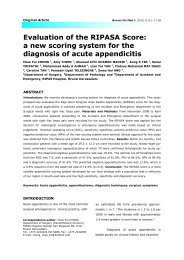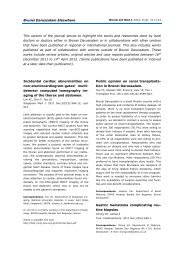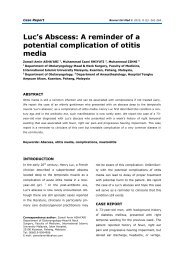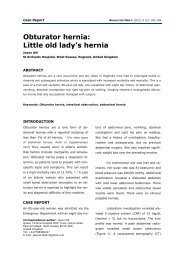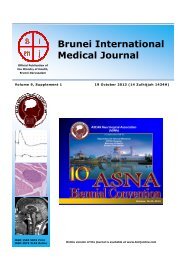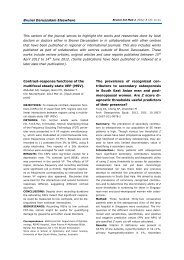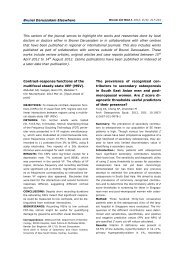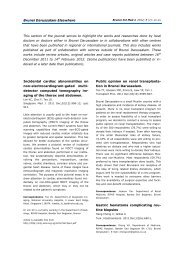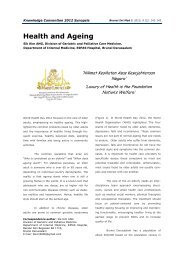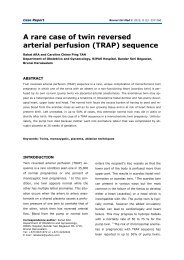BIMJ October 2012 Latest 2
BIMJ October 2012 Latest 2
BIMJ October 2012 Latest 2
Create successful ePaper yourself
Turn your PDF publications into a flip-book with our unique Google optimized e-Paper software.
Case Report<br />
Brunei Int Med J. <strong>2012</strong>; 8 (6): 358-361<br />
Plasmodium knowlesi malaria<br />
infection in human<br />
Thomas NINAN 1 , Khalid NALEES 1 , Maung NEWIN 1 , Qaiser SULTAN 1 , Moe Moe THAN 1 ,<br />
Suresh SHINDE 1 , Ann Velerie Fernandez HABANA 1 and Noorainun MOHD YUSOF 2 ,<br />
1 Department of Critical Care Medicine and 2 Department of Medicine,<br />
RIPAS Hospital, Bandar Seri Begawan, Brunei Darussalam<br />
ABSTRACT<br />
Plasmodium knowlesi (P. knowlesi) is a species of Plasmodium that rarely infect humans compared to<br />
P. vivax, falciparum, ovale and malariae, and has been considered as the fifth malaria species. There is<br />
a large reservoir of P. knowlesi in the whole of Eastern Malaysia and in most states of Western Malaysia,<br />
particularly in Macaque monkeys. We report the rare case of a 58-year-old man who presented<br />
with septic shock secondary to P. knowlesi who was successfully treated.<br />
Keywords: Malaria, septiceamia, acute kidney injury<br />
INTRODUCTION<br />
Plasmodium knowlesi (P. knowlesi) is considered<br />
the fifth malaria species. Unlike the other<br />
Plasmodium species, infections with P.<br />
knowlesi in human are rare. This species was<br />
first isolated in 1931 from a long tailed macaque<br />
monkey which was imported to India<br />
from Singapore. 1 It was first shown to be<br />
infectious to humans in 1932. 2 The first human<br />
infection was reported in 1965. 2<br />
gapore, the Philippines, Vietnam and Indonesia.<br />
Its natural hosts are the macaques and<br />
banded leaf monkeys. The vector for transmission<br />
to humans is the mosquito – Anopheles<br />
leucosphyrus group. Humans acquire this<br />
infection when they travel to forested areas<br />
where both the natural hosts and the vectors<br />
are present. Although the natural host is present<br />
in the urban setting, transmission is unusual<br />
due to absence of the vector.<br />
There is a large reservoir of P. knowlesi<br />
in the whole of Eastern Malaysia and in<br />
most states of Western Malaysia. 1 It has also<br />
been reported from Thailand, Myanmar, Sin-<br />
Correspondence author: Ninan THOMAS<br />
Department of Critical Care Mediciine,<br />
RIPAS Hospital, Bandar Seri Begawan BA 1710,<br />
Brunei Darussalam.<br />
Tel: +673 2242424 Ext 3459, Fax: +673 2242690<br />
E mail: ninanthomas@brunet.bn<br />
We report the case of a 58-year-old<br />
man with P. knowlesi infection who presented<br />
with septicaemic shock, acute respiratory distress<br />
syndrome and acute kidney injury.<br />
CASE REPORT<br />
A 58-year-old farmer presented to the Accident<br />
and Emergency Department with a history<br />
of being unwell with loss of appetite for<br />
approximately a week. He had fever that was
NINAN et al. Brunei Int Med J. <strong>2012</strong>; 8 (6): 359<br />
Figs. 1: a) Blood film showing parasitised red blood cells (H&E stain, x10), and b) a magnified image showing<br />
Malaria knowlesi inside the erythrocytes (H&E stain, x100).<br />
associated with dyspnoea for the previous<br />
three days. He also had coffee ground vomitus<br />
prior to admission. His oxygen saturation<br />
through a facemask with an oxygen flow rate<br />
of 8 L/minute, ranged between 62% and<br />
64%.<br />
He was immediately referred to the<br />
Critical Care Medicine Department. On examination<br />
he was conscious, and comfortable but<br />
was febrile (38.1 o C) and had central cyanosis.<br />
He was haemodynamically stable (pulse rate<br />
97/min and blood pressure 137/76mmHg).<br />
His oxygen saturation fluctuated between<br />
70% and 100%, and he was transferred to<br />
the Intensive Care Unit (ICU). Urgent arterial<br />
blood gas analysis revealed metabolic acidosis<br />
with respiratory compensation (pH 7.341,<br />
PaO 2 77.3mmHg, PCO 2 22.3mHg, HCO 3<br />
11.8mmol/L and base excess of –11.6mmol/<br />
l). The serum lactate was elevated at<br />
8.34mmol/L.<br />
Admission chest radiograph was otherwise<br />
unremarkable. Laboratory investigations<br />
showed serum haemoglobin to be 13.2<br />
gm/dL, markedly elevated white cell count of<br />
39.5 x 10 9 /L (7.0 to 11.0) and thrombocyte–<br />
paenia of 31 X 10 9 /L (150 to 450). CRP was<br />
26.09mg/dL (
NINAN et al. Brunei Int Med J. <strong>2012</strong>; 8 (6): 360<br />
antibiotics (ceftazidime and co-amoxiclav)<br />
and oral doxycycline to cover for concomitant<br />
bacterial infection. Blood and platelet transfusions<br />
were also given.<br />
His condition was complicated by<br />
acute kidney injury with minimal urine output.<br />
Renal replacement therapy was started. On<br />
the third day of admission, he developed respiratory<br />
failure and required endotracheal intubation<br />
with mechanical ventilatory support.<br />
Chest radiograph revealed bilateral alveolar<br />
opacities with normal cardiac size, consistent<br />
with acute respiratory distress syndrome.<br />
Forty-eight hours after starting quinine,<br />
the parasite index dropped to 1.6%. No<br />
parasites were seen on the fifth day. The<br />
platelet count normalised by the seventh day.<br />
On the eleventh day, his progress was complicated<br />
by gastrointestinal bleeding. An urgent<br />
upper gastrointestinal endoscopy only showed<br />
gastritis. His bleeding settled and a colonoscopy<br />
done two days later showed a circumferential<br />
ulcer with irregular edges in the sigmoid<br />
colon. Biopsies revealed broad fungal<br />
hyphae, aseptate with right angled branching<br />
consistent with mucormycosis. Intravenous<br />
Liposomal Amphotericin B was started. His<br />
condition improved and he was extubated on<br />
the 20 th day and recovered without any further<br />
complications.<br />
DISCUSSION<br />
P. knowlesi is unusual among malaria parasite<br />
of primates in that it has relaxed host specificity<br />
(humans and monkeys) but is vector<br />
restricted to the Anopheles leucosphyrus<br />
group. 3 It has the shortest erythrocytic cycle<br />
of all the malaria species affecting humans.<br />
Daily schizont rupture leads to pyrexia every<br />
24 hours. Interestingly, due to its ability to<br />
induce daily pyrexia, it was used in the 1930s<br />
as a pyretic agent for the treatment of neurosyphilis.<br />
2 The early trophozoite stages (ring<br />
forms) are morphologically identical to P. falciparum,<br />
while the later stages (late tropozoites,<br />
schizonts and gametocytes) are identical<br />
to P. malariae. 1, 3 Unlike P. malariae which<br />
seldom exceeds 5000 parasites per ml of<br />
blood and has a benign clinical course, P.<br />
knowlesi causes very high parasitemia and<br />
can cause multiple organ dysfunction. 1, 3 A<br />
polymerase chain reaction-based assay is also<br />
available for definitive identification of P.<br />
knowlesi but is not recommended for routine<br />
use. 2<br />
The incubation period of P. knowlesi is<br />
9 to 12 days. The clinical features described<br />
in literature are similar to other plasmodial<br />
infections consisting of constitutional symptoms,<br />
pyrexia with chills and rigor. In contrast<br />
to other forms of malaria, the spike of fever in<br />
P. knowlesi is daily. Similar to the other forms<br />
of malaria, thrombocytopaenia is a consistent<br />
feature. However, clinical bleeding due to the<br />
thrombocytopenia is rare. In our setting,<br />
where dengue fever is common, this needs to<br />
be excluded. Cerebral dysfunction has not<br />
been reported 1 but depressed consciousness<br />
can occur due to hypoglycaemia. However,<br />
hypoglycaemia per se is unusual in this form<br />
of malaria. 1 Multiple organ dysfunctions can<br />
occur in complicated cases, and renal function<br />
can be significantly deranged requiring renal<br />
replacement therapy.<br />
P. knowlesi is sensitive to all antimalarial<br />
medications. Chloroquine, quinine<br />
and artemether-lumefantrine combination and<br />
doxycycline have all been used in treatment.
NINAN et al. Brunei Int Med J. <strong>2012</strong>; 8 (6): 361<br />
No resistance, recrudescence or relapse has<br />
been reported to date. 1 However, in severe<br />
malaria, the mortality was reported to be<br />
27% as results of multiple organ dysfunctions.<br />
4 Since it has no late exo-erythrocytic<br />
hepatic phase, primaquine is not indicated in<br />
the treatment regime. 1<br />
In conclusion, we report a rare case<br />
of P. knowlesi that presented with septicaemic<br />
shock, acute respiratory distress syndrome<br />
and acute kidney injury. Our patient<br />
did not have any other comorbid conditions.<br />
Although we have encountered few rare cases<br />
of P. knowlesi in our local setting, a case with<br />
such presentation has never been reported.<br />
We hope this case will highlight to clinicians<br />
to consider this diagnosis in patients who are<br />
at risk of contracting malaria infection.<br />
REFERENCES<br />
1: Singh B, Dhaneshwar C. Plasmodium knowlesi<br />
Malaria in Malaysia. Med J Malaysia 2010; 65: 224-<br />
30.<br />
2: Singh B, Sung LK, Matusop A, et al. A large focus<br />
of naturally acquired Plasmodium knowlesi infections<br />
in human beings. Lancet 2004; 363:1017–<br />
24.<br />
3: Singh CS, Davis TME, Lee KS, et al. Plasmodium<br />
knowlesi malaria in humans is widely distributed<br />
and potentially life threatening. Clin Infect Dis.<br />
2008; 46:165–7.<br />
4: William T, Menon J, Rajahram G, et al. Severe<br />
Plasmodium knowlesi malaria in a tertiary care hospital<br />
in Sabah, Malaysia. CDC 2011: 17. Available<br />
from http://wwwnc.cdc.gov/eid/article/17/7/10-<br />
1017_article.htm (Accessed 15 th February <strong>2012</strong>).



